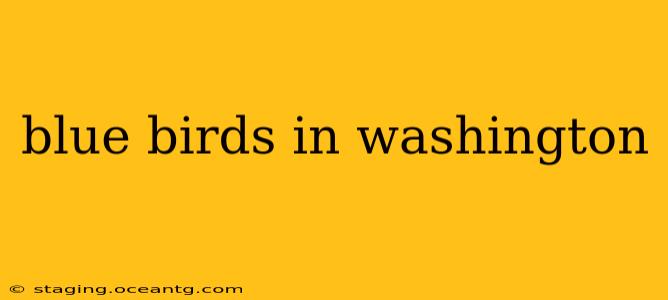Washington state boasts a diverse avian population, and several species of blue birds grace its skies. Understanding which blue birds you might spot, where they're located, and what makes them unique is key to enjoying the vibrant birdlife of the Evergreen State. This guide will explore the most common blue birds found in Washington, addressing common questions about their habitat, behavior, and conservation.
What are the different types of blue birds in Washington?
Several species exhibiting varying shades of blue can be found in Washington. The most commonly seen are the Western Bluebird, Mountain Bluebird, and occasionally, the Steller's Jay (which features blue in its plumage). While not strictly a "bluebird" in the family Sialia, the Steller's Jay deserves mention due to its striking blue coloring. Focusing on the true bluebirds, the Western Bluebird is generally found in lower elevations and open woodlands, while the Mountain Bluebird prefers higher altitudes and more open habitats.
Where can I find blue birds in Washington?
The location of bluebirds greatly depends on the species and the time of year.
-
Western Bluebirds: These birds prefer open areas with scattered trees and shrubs. You’ll find them in orchards, meadows, and parklands across western Washington. They are less common in the eastern parts of the state.
-
Mountain Bluebirds: As their name suggests, Mountain Bluebirds are found at higher elevations, in the mountains of eastern Washington and across the Cascade Range. Look for them in open meadows, alpine areas, and along mountain roads.
-
Steller's Jays: These birds are more widespread, inhabiting forests and woodlands across Washington, from lowlands to mountainous regions.
Specific locations often reported for bluebird sightings include various state parks and wildlife areas throughout Washington. Checking local birding websites and forums can provide up-to-date information on specific locations where bluebirds have been recently spotted.
What time of year can I see blue birds in Washington?
Bluebird sightings depend on the species and the season. Western Bluebirds are year-round residents in some parts of western Washington, though some may migrate to lower elevations during winter. Mountain Bluebirds are more migratory, with many leaving Washington for lower latitudes during winter months. The best time to see them is during the breeding season (spring and summer). Steller's Jays are resident birds year-round in Washington.
What do blue birds eat in Washington?
The diet of bluebirds varies slightly by species, but generally consists of insects and berries.
-
Insects: Both Western and Mountain Bluebirds are primarily insectivores, feeding on beetles, grasshoppers, and caterpillars.
-
Berries: They supplement their diet with various berries and fruits depending on seasonal availability.
Are blue birds endangered in Washington?
Neither the Western nor the Mountain Bluebird is currently listed as endangered in Washington. However, habitat loss and degradation remain ongoing concerns for all bird species. Supporting conservation efforts, such as protecting natural habitats and avoiding the use of harmful pesticides, is crucial for the continued well-being of these beautiful birds.
How can I attract blue birds to my backyard in Washington?
Attracting bluebirds to your backyard requires providing them with suitable habitat and food sources.
-
Nest Boxes: Installing bluebird houses (specifically designed for the size and preference of Western Bluebirds) can significantly increase the chance of attracting nesting pairs. Proper placement and maintenance of nest boxes are critical for their success.
-
Food Sources: While they hunt insects naturally, providing a water source and planting berry-producing shrubs can help attract them to your yard.
-
Open Habitat: Maintaining open areas with short grass and some scattered trees and shrubs will mimic their preferred nesting and foraging habitats.
By understanding the unique characteristics and needs of each bluebird species, residents of Washington can better appreciate and protect these vibrant additions to the state's natural beauty. Enjoy the rewarding experience of observing these captivating birds in their natural environment!
